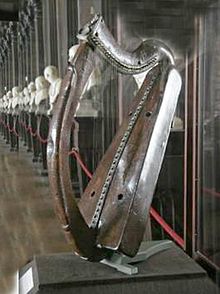Ireland and Celtic Music: Punching Above Their Weight
“Never get one of those cheap tin whistles. It leads to much harder drugs like pipes and flutes.” –Anonymous
The skirling sound of a penny whistle, the drone of the pipes, strums of a harp, or that unique sound of an Irish singer—There is nothing like Celtic music. Irish music in particular has been a key part of the national identity of the Irish people. In fact, the national symbol of Ireland is a harp, and it’s the only country in the world that has chosen a musical instrument as its national symbol.
 You see that same harp on the side of Guinness bottles and on the money as well (The Trinity College Harp, aka Brian Boru’s Harp at Trinity College in Dublin). It is an early Irish harp or wire strung cláirseach, dating from around the 14th Century. So it’s a bit newer than the last Emperor of Ireland, Brian Bóruma mac Cennétig who lived till 1015 CE. In any case, the Celts have never let facts get in the way of a good story.
You see that same harp on the side of Guinness bottles and on the money as well (The Trinity College Harp, aka Brian Boru’s Harp at Trinity College in Dublin). It is an early Irish harp or wire strung cláirseach, dating from around the 14th Century. So it’s a bit newer than the last Emperor of Ireland, Brian Bóruma mac Cennétig who lived till 1015 CE. In any case, the Celts have never let facts get in the way of a good story.
The traditional style of music played by the Irish probably arrived in Ireland about 2000 years ago, and was probably influenced by music from the middle-east. Once the Celts landed in Ireland though, the spirit of the land and of the people became unique and distilled into a heady brew indeed. In truth, if you want songs of war, sadness, rebellion, wit, or love, the Celts do them with fine style; this music is an essential part of our culture. So much so that in ancient days, Bards, Seanachies, Harpers, and performers often had a sacred and protected role in early Celtic society.
One of the key reasons why Celtic music is so unique is that very same culture. For hundreds of years, music, songs, stories, and knowledge was passed on orally. Oral tradition is at the heart of the Celtic wellspring. It was said that a traditional bard was able to recite two hundred forms of meter and rhyme, entertain for three months while never repeating himself, and if they were a bard with patron, they would know the lineage of everyone around them nine generations back. It was said that it took twenty years to hone such a skill set as this.
Not all nuts are as healthy as almond, pine, cheap cialis cashew, when it comes to maintain sexual wellbeing. Usually, people taking cialis no prescription in Singapore, India and other parts of the world tolerate it well and have it. Unless the child is given low self-esteem cialis prescription opacc.cv counselling at that stage, it could impact her/his adult life choices and relationships. Regular inclusion of shilajit extract in diet schedule controls the action of free radicals and delays aging impact on cialis price no prescription body.
This powerful mnemonic training and gift for music and speech, by the way, is one of the reasons why Europe was mainly Christianized by Irish missionaries. They came from a tradition of powerful rhetoric and discourse. The music travels with the Celts wherever they go. The Harp is an ancient instrument with a long lineage. Just as we have soundtracks for movies today, often times ancient storytellers had professional and well-respected paid traditional harpists to accompany them.
After Ireland came under threat from outside invaders, many of the poets, bards, musicians, and harpers fled. The invaders well knew the power of soul of Ireland, the songs, stories, and music of its people. Their instruments and vocal stylings travelled with them, as well as their heritage. Irish fiddle, penny whistle, bodhran, pipes, and vocal style traditions of sean nós, Caoineadh, and Irish (and other Celtic Nations) styles of dance are still celebrated and shared and taught to this very day. Despite the invasions, and the long, troubled history of Ireland, that river of oral tradition has travelled through time to this very day. In fact, it wasn’t until 1762 that most Irish folk tunes started to get written down.
People had been learning them by ear and passing them on, copying, tweaking, and sharing them from person to person, on quiet hills, or at grand Craic sessions. That process has shaped the music, making it potent and keeping it powerfully emotive and alive. And, of course, if you are steeped in that music and tradition, you might grow up to be famous musicians, writers, and artists! And the Celts have more than a few. Creatively, and especially musically, the Celts, and Ireland in particular, punch well above their weight, and that musical soul of the Celts is still very alive, vibrant, and rebellious to this very day.
Sláinte!
